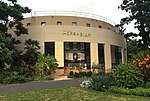Great Melbourne Telescope

The Great Melbourne Telescope was built by Thomas Grubb in Dublin, Ireland in 1868, and installed at the Melbourne Observatory in Melbourne, Australia in 1869. In 1945 that Observatory closed and the telescope was sold and moved to the Mount Stromlo Observatory near Canberra. It was rebuilt in the late 1950s. In 2003 the telescope, still in use as an observatory, was severely damaged in a bushfire. About 70% of the components were salvageable; a project to restore the telescope to working condition started in 2013. With a 48 inch (1.2 meter) diameter primary mirror, it was one of the largest telescopes of the late 19th century. This is a significant size even into the 21st century, although the lower reflecting ability of speculum metal mirrors (about 2/3 reflected) makes them inferior to later metal-on-glass designs or large refractors. This was significantly larger than the largest refractors of the period such as the Lick telescope and Yerkes, although those were both in the northern hemisphere (they would view the northern skies as opposed to the southern)
Excerpt from the Wikipedia article Great Melbourne Telescope (License: CC BY-SA 3.0, Authors, Images).Great Melbourne Telescope
Anderson Street, Melbourne South Yarra
Geographical coordinates (GPS) Address Website Nearby Places Show on map
Geographical coordinates (GPS)
| Latitude | Longitude |
|---|---|
| N -37.8297 ° | E 144.976 ° |
Address
Royal Botanic Gardens
Anderson Street
3141 Melbourne, South Yarra
Victoria, Australia
Open on Google Maps









